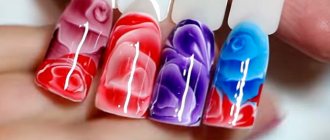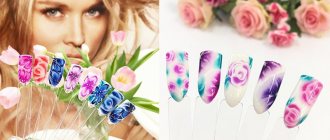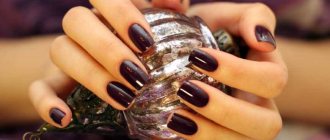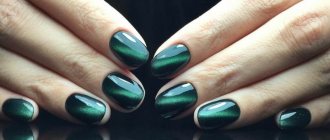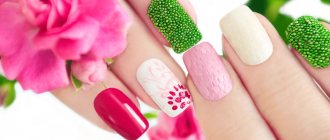Knowing how to mix and match different nail polish colors is the first step to creating the unique and creative manicure you've seen in fashion magazines or on Instagram from nail art professionals.
Even the simplest nail shapes can be given a unique look if you combine the right polish colors with each other, while the wrong colors can ruin the entire manicure, despite the fact that you spent several hours creating it. Today it is considered boring to wear nails painted in one color, so if you do not yet know the principles of creating a stylish manicure, then it is time to learn which colors can be mixed with each other and which cannot.
Learn these basic rules for combining different colored nail polishes and you can rightfully consider yourself a professional manicurist.
Nail polish color combination: “Two tone” technique
Nails painted in one color are an all-time classic. But what if you attract more attention by adding a second color to your classic manicure? One of the simplest techniques for combining two colors is the Ombre technique, which involves creating the most beautiful and smooth transition of colors, which results in a gradient on the nails. A manicure using the Ombre technique does not show a very strong change in the degree of saturation of the main color, so you can use two different tones of the same color.
This technique allows you to combine different shades of the same color: from the lightest to the darkest, thus obtaining a wide variety of types of manicure. For variety, it is not necessary to choose shades of the same color; you can choose corresponding colors from the same color range. For example, blue and purple, green and pale blue.
Instructions for applying nude tones
First, turn the bottle over and roll it between your palms to mix the white pigment. Then make a few confident strokes with a brush, which is held so that it lies on the nail. The brush seems to become an extension of the finger. The coating is applied in two stages.
First stage:
- A drop of light gel polish is placed near the cuticle and carefully brought as close as possible to the proximal roller. Afterwards, carefully stretch the gel polish with a brush to the free edge.
- The brush is placed on the left side of the nail so that the cap points to the left of the middle of the nail. Carefully stretch the gel polish from the left of the middle of the nail to the free edge.
- Repeat the operation for the right side of the nail.
- Movement from the cuticle to the free edge “through the air”. The end is sealed. The nail is placed in a lamp for polymerization.
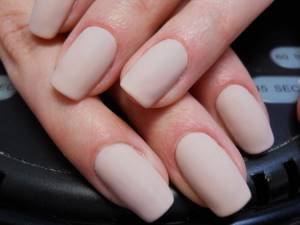
The second stage of applying light-colored gel polish to the nails is almost the same:
- A drop is placed near the cuticle, slightly short of it, and extended to the free edge.
- The brush is placed on the left side of the nail so that the cap points to the right of the middle of the nail. The left side of the nail is painted.
- Repeat the operation for the right side of the nail.
- Movement from the cuticle to the free edge “through the air”. The end is sealed. The nail is placed in a lamp for polymerization.
Great set for stamping as a gift!
Contents: 10 special acrylic varnish for transferring designs (11 ml): white, black, pink, green, yellow, red, blue, dark red, silver, gold 10 stencils: M04, M05, M06, M07, M08, M09, M16 , M20, M22, M24.1 transparent fixative (11 ml) 1 stamp, 2 scrapers, 1 file, 1 three-sided buffer, 1 tweezers, 1 acrylic stick (long), 1 set of rhinestones (50 pieces).
BUY A STAMPING SET
This way, you can create harmony between brightness and saturation by using light and dark shades of the same tone. Here are more examples of combinations: sky blue and blue, lavender and lilac, purple and violet, green and turquoise or aquamarine and emerald.
It is necessary to pay attention to the texture of the varnish. Remember that the varnishes must be of the same texture. That is, if you took one varnish in a matte shade, then the second one should be matte. This also applies to shiny varnishes.
You can create a bold and stunning manicure by mixing and matching contrasting shades using the ombre technique. To do this, it is important to follow the basic rule of blocking shades so as not to make a mistake with the choice of color. Try these combinations of shades: orange with dark blue, sky blue and light brown, yellow and violet, violet and aquamarine, regular red with green, etc.
When using bright colors, you must be very careful not to make a mistake, as an accidental brush stroke can ruin the entire nail. Be careful.
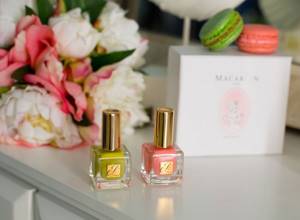
The next technique is to use an achromatic color combination.
Achromatic shades are considered neutral and therefore can be safely combined with any known color. Achromatic colors include white, black and all shades of gray.
Choose one neutral shade as your base tone and add any of the light or pastel shades to it. For example, you can take a combination of black and white, or black and red. Black with gold or silver, white with any shade of blue, gray with pink look good.
If the Ombre technique seems too complicated for you, then you can create a fun manicure for your nails from two shades, by smoothly transitioning each of them. For best results, use varnish in two identical shades. You can start with your thumb nail, using a bright or dark shade, and then paint the rest in order, using a lighter shade each time. Using glitter, you can achieve a beautiful color pair of almost any shade.
All of the above methods of combining two different nail polish colors can also be used not only to create the famous Ombre effect, but also for many other complex nail art combinations. You can take one of the combining colors as a base, and use the second to draw various designs on your nails. When playing with contrasting tones, it is recommended to use neutral or bright colors as the background, and correspondingly bright or neutral colors for painting.
Nail polish color combination: general rules
Whether you want to create a stylish two-tone manicure or turn your nails into a colorful work of art, you should have a basic understanding of which nail polishes go together and which don't.
While nail technicians can sense colors and intuitively create beautiful color combinations on their nails, others must follow certain color blocking rules to avoid looking tacky.
In addition to the well-known colors of the rainbow (yellow, orange, red, cyan, indigo, green, violet), the color wheel can contain another color - magenta, which lies between red and violet.
In addition, there is the concept of “primary shades”, which are yellow, green, blue and red. Mixing primary colors and adding black and white shades to them allows you to create other colors. In addition, neutral colors include black, white and their shades.
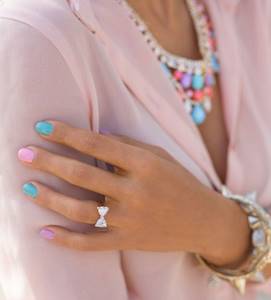
You should also be able to distinguish between warm and cool shades. If the color has shades of yellow or red, then it belongs to the group of warm tones, and if it has shades of blue or green, it is considered cold. The universal rule for mixing colors is to combine warm shades with warm ones and cold shades with cold ones. Avoid combining warm and cold shades of the same color in your manicure. For example, blue-green with yellowish-green, crimson-red with orange-red. Also, when choosing a specific nail polish, you need to take into account the makeup and color scheme of the outfit. Try to create harmony or contrast between them.
Instructions for applying pearlescent tones
Light gel polishes with mother-of-pearl have another problem: the particles of mother-of-pearl are not so small that they are not visible. Their enchanting iridescent glow is accompanied by the pattern of marks that remain from the brush. The smallest particles line up in lines. They are visible in certain lighting. It is very unsightly when these lines intersect or create zigzags. The coating is done in two stages.

First stage:
- The angle of the brush is 45%; use the brush to place a drop near the cuticle. Carefully reaches towards the free edge.
- Using a brush, paint the left side of the nail with a confident movement, with the cap pointing to the right.
- With a confident brush, paint the right side of the nail, with the cap directed to the left.
- The end is sealed and the hand is placed in the lamp.
The second stage completely repeats the first.
What colors of nail polishes go together?
We invite you to explore the most winning nail polish color combinations
- White. This versatile color can be paired with literally any color. The best combination would be to use blue, red and black.
- Beige. Combines with blue, brown, emerald, black, red and white.
- Grey. This neutral shade pairs perfectly with moody colors such as fuchsia, red, purple, pink and blue.
- Pink. This "glamorous" color goes well with brown, white, green, mint, olive, gray, turquoise, burgundy and pale blue.
- Fuchsia. The best colors to combine with fuchsia are gray, yellow, brown, green, mint, brown.
- Red. The most passionate color on the color wheel, it goes well with yellow, white, brown, green, blue and black.
- Tomato. Mint, sand, cream and gray go well with this shade of red.
- Crimson. Can be grouped with white, black and pink colors.
- Brown. This color goes well with bright blue, cream, pink, yellow, green and beige.
- Light brown. Shades of light brown include pale yellow, cream, blue, green, purple and red.
- Dark brown. Suitable colors for this color include canary, blue, mint, purple, pink and lime.
- Orange. The best colors to combine would be blue, blue, violet, purple, white and black.
- Light orange. Feel free to choose gray, brown or olive.
- Dark orange. Dark orange corresponds to pale yellow, olive, brown and cherry.
- Yellow. Blue, lilac, purple, gray or black are suitable.
- Citric. Cherry red, brown, blue and gray colors go well with this citrusy shade.
- Pastel. A wonderful soft yellow color will complement fuchsia, grey, brown, shades of red, tan, blue and purple.
- Gold. Gray, brown, azure, red and black go well with golden nail polish.
- Light green. Golden brown, pink, dark orange, navy or gray would be a great addition.
- Olive. Looks great with orange, tan and brown.
- Green. Suitable colors include golden brown, orange, light green, yellow, brown, grey, cream and black.
- Light green. This shade of green goes well with brown, light yellow, grey, dark blue and red.
- Turquoise. The best combinations are with fuchsia, cherry, yellow, brown, cream and dark purple.
- Blue. Pairs with red, grey, brown, orange, pink, white and yellow.
- Dark blue. All shades of blue are combined with lilac, blue, yellowish-green, brown, gray, yellow, orange, green, red and white.
- Lilac. This beautiful delicate color is complemented by orange, pink, dark purple, olive, gray, yellow and white.
- Dark purple. This luxurious color looks stunning when paired with golden brown, pastel, grey, turquoise, mint green and light orange.
- Burgundy. Green, blue-green, gray, pink and blue colors.
- Black. Versatile for all times, looks elegant with orange, pink, light green, white, red, lilac or yellow.
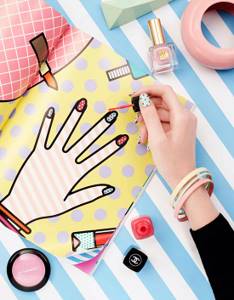
By sticking to these general color combinations, you will be sure that your nails look fabulous. They will be your decoration not only on special occasions, but also every day. Try it, experiment.

